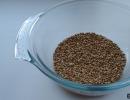Abbreviated multiplication formulas. Quickly square numbers without a calculator What does a number squared mean
Abbreviated multiplication formulas.
Study of abbreviated multiplication formulas: the square of the sum and the square of the difference of two expressions; difference of squares of two expressions; the cube of the sum and the cube of the difference of two expressions; sum and difference of cubes of two expressions.
Application of abbreviated multiplication formulas when solving examples.
To simplify expressions, factorize polynomials, and bring polynomials to a standard form, abbreviated multiplication formulas are used. Abbreviated multiplication formulas need to be known by heart.
Let a, b R. Then:
1. The square of the sum of the two expressions is the square of the first expression plus twice the product of the first expression by the second plus the square of the second expression.
(a + b) 2 = a 2 + 2ab + b 2
2. The squared difference of the two expressions is the square of the first expression minus twice the product of the first expression by the second plus the square of the second expression.
(a - b) 2 = a 2 - 2ab + b 2
3. Difference of squares two expressions is equal to the product of the difference between these expressions and their sum.
a 2 - b 2 = (a -b) (a + b)
4. Sum cube of two expressions is equal to the cube of the first expression plus three times the square of the first expression and the second plus three times the product of the first expression and the square of the second plus the cube of the second expression.
(a + b) 3 = a 3 + 3a 2 b + 3ab 2 + b 3
5. Difference cube two expressions is equal to the cube of the first expression minus three times the square of the first expression and the second plus three times the product of the first expression and the square of the second minus the cube of the second expression.
(a - b) 3 = a 3 - 3a 2 b + 3ab 2 - b 3
6. Sum of cubes two expressions is equal to the product of the sum of the first and second expressions by the incomplete square of the difference of these expressions.
a 3 + b 3 = (a + b) (a 2 - ab + b 2)
7. Difference of cubes two expressions is equal to the product of the difference of the first and second expressions by the incomplete square of the sum of these expressions.
a 3 - b 3 = (a - b) (a 2 + ab + b 2)
Application of abbreviated multiplication formulas when solving examples.
Example 1.
Calculate
a) Using the formula for the square of the sum of two expressions, we have
(40 + 1) 2 = 40 2 + 2 40 1 + 1 2 = 1600 + 80 + 1 = 1681
b) Using the formula for the square of the difference of two expressions, we get
98 2 = (100 - 2) 2 = 100 2 - 2 100 2 + 2 2 = 10000 - 400 + 4 = 9604
Example 2.
Calculate
Using the formula for the difference between the squares of the two expressions, we get
Example 3.
Simplify expression
(x - y) 2 + (x + y) 2
We use the formulas for the square of the sum and the square of the difference of two expressions
(x - y) 2 + (x + y) 2 = x 2 - 2xy + y 2 + x 2 + 2xy + y 2 = 2x 2 + 2y 2
Abbreviated multiplication formulas in one table:
(a + b) 2 = a 2 + 2ab + b 2
(a - b) 2 = a 2 - 2ab + b 2
a 2 - b 2 = (a - b) (a + b)
(a + b) 3 = a 3 + 3a 2 b + 3ab 2 + b 3
(a - b) 3 = a 3 - 3a 2 b + 3ab 2 - b 3
a 3 + b 3 = (a + b) (a 2 - ab + b 2)
a 3 - b 3 = (a - b) (a 2 + ab + b 2)
Today we will learn how to quickly square large expressions without a calculator. By large, I mean numbers between ten and one hundred. Large expressions are extremely rare in real problems, and you can count values less than ten anyway, because this is a common multiplication table. The material of today's lesson will be useful for fairly experienced students, because novice students simply will not appreciate the speed and effectiveness of this technique.
First, let's figure out what this is all about. For example, I propose to make the construction of an arbitrary numerical expression, as we usually do. Let's say 34. We raise it, multiplying it by itself by a column:
\ [((34) ^ (2)) = \ times \ frac (34) (\ frac (34) (+ \ frac (136) (\ frac (102) (1156)))) \]
1156 is square 34.
The problem with this method can be described in two points:
1) it requires written registration;
2) it is very easy to make a mistake in the calculation process.
Today we will learn fast multiplication without a calculator, verbally and practically without errors.
So let's get started. To work, we need the formula for the square of the sum and difference. Let's write them down:
\ [(((a + b)) ^ (2)) = ((a) ^ (2)) + 2ab + ((b) ^ (2)) \]
\ [(((a-b)) ^ (2)) = ((a) ^ (2)) - 2ab + ((b) ^ (2)) \]
What does it give us? The fact is that any value in the range from 10 to 100 can be represented as the number $ a $, which is divisible by 10, and the number $ b $, which is the remainder of the division by 10.
For example, 28 can be represented as follows:
\ [\ begin (align) & ((28) ^ (2)) \\ & 20 + 8 \\ & 30-2 \\\ end (align) \]
We present the remaining examples in a similar way:
\ [\ begin (align) & ((51) ^ (2)) \\ & 50 + 1 \\ & 60-9 \\\ end (align) \]
\ [\ begin (align) & ((42) ^ (2)) \\ & 40 + 2 \\ & 50-8 \\\ end (align) \]
\ [\ begin (align) & ((77) ^ (2)) \\ & 70 + 7 \\ & 80-3 \\\ end (align) \]
\ [\ begin (align) & ((21) ^ (2)) \\ & 20 + 1 \\ & 30-9 \\\ end (align) \]
\ [\ begin (align) & ((26) ^ (2)) \\ & 20 + 6 \\ & 30-4 \\\ end (align) \]
\ [\ begin (align) & ((39) ^ (2)) \\ & 30 + 9 \\ & 40-1 \\\ end (align) \]
\ [\ begin (align) & ((81) ^ (2)) \\ & 80 + 1 \\ & 90-9 \\\ end (align) \]
What gives us such an idea? The fact is that with the sum or difference, we can apply the above calculations. Of course, to shorten the calculations, for each of the elements one should choose an expression with the smallest second term. For example, from the $ 20 + $ 8 and $ 30-2 $ options, you should choose the $ 30-2 $ option.
Similarly, we select the options for the rest of the examples:
\ [\ begin (align) & ((28) ^ (2)) \\ & 30-2 \\\ end (align) \]
\ [\ begin (align) & ((51) ^ (2)) \\ & 50 + 1 \\\ end (align) \]
\ [\ begin (align) & ((42) ^ (2)) \\ & 40 + 2 \\\ end (align) \]
\ [\ begin (align) & ((77) ^ (2)) \\ & 80-3 \\\ end (align) \]
\ [\ begin (align) & ((21) ^ (2)) \\ & 20 + 1 \\\ end (align) \]
\ [\ begin (align) & ((26) ^ (2)) \\ & 30-4 \\\ end (align) \]
\ [\ begin (align) & ((39) ^ (2)) \\ & 40-1 \\\ end (align) \]
\ [\ begin (align) & ((81) ^ (2)) \\ & 80 + 1 \\\ end (align) \]
Why should you strive to decrease the second term during fast multiplication? It's all about the original calculations of the square of the sum and difference. The point is that the plus or minus term $ 2ab $ is the most difficult to calculate when solving real problems. And if the multiplier $ a $, a multiple of 10, is always multiplied easily, then with the multiplier $ b $, which is a number in the range from one to ten, many students regularly have difficulties.
\[{{28}^{2}}={{(30-2)}^{2}}=200-120+4=784\]
\[{{51}^{2}}={{(50+1)}^{2}}=2500+100+1=2601\]
\[{{42}^{2}}={{(40+2)}^{2}}=1600+160+4=1764\]
\[{{77}^{2}}={{(80-3)}^{2}}=6400-480+9=5929\]
\[{{21}^{2}}={{(20+1)}^{2}}=400+40+1=441\]
\[{{26}^{2}}={{(30-4)}^{2}}=900-240+16=676\]
\[{{39}^{2}}={{(40-1)}^{2}}=1600-80+1=1521\]
\[{{81}^{2}}={{(80+1)}^{2}}=6400+160+1=6561\]
So in three minutes we did the multiplication of eight examples. This is less than 25 seconds for each expression. In reality, after a little practice, you will count even faster. It will take you no more than five to six seconds to calculate any two-digit expression.
But that's not all. For those to whom the shown technique seems not fast enough and not cool enough, I propose an even faster method of multiplication, which, however, does not work for all tasks, but only for those that differ by one from multiples of 10. In our lesson there are four such values: 51, 21, 81 and 39.
It would seem that much faster, we already count them literally in a couple of lines. But, in fact, you can accelerate, and this is done as follows. We write down the value, a multiple of ten, which is closest to the desired one. For example, let's take 51. So to start with, let's build fifty:
\[{{50}^{2}}=2500\]
Multiples of ten are much easier to square. Now we just add fifty and 51 to the original expression. The answer is the same:
\[{{51}^{2}}=2500+50+51=2601\]
And so with all numbers that differ by one.
If the value we are looking for is greater than the one we are counting, then we add numbers to the resulting square. If the desired number is less, as in the case of 39, then when performing the action, you need to subtract the value from the square. Let's practice without using a calculator:
\[{{21}^{2}}=400+20+21=441\]
\[{{39}^{2}}=1600-40-39=1521\]
\[{{81}^{2}}=6400+80+81=6561\]
As you can see, in all cases the answers are the same. Moreover, this technique is applicable to any adjacent values. For example:
\ [\ begin (align) & ((26) ^ (2)) = 625 + 25 + 26 = 676 \\ & 26 = 25 + 1 \\\ end (align) \]
At the same time, we do not need to remember the calculations of the squares of the sum and difference and use the calculator at all. The speed of work is beyond praise. Therefore, memorize, practice and use in practice.
Key points
With this technique, you can easily multiply any natural numbers in the range from 10 to 100. Moreover, all calculations are performed orally, without a calculator and even without paper!
First, remember the squares of values that are multiples of 10:
\ [\ begin (align) & ((10) ^ (2)) = 100, ((20) ^ (2)) = 400, ((30) ^ (2)) = 900, ..., \\ & ((80) ^ (2)) = 6400, ((90) ^ (2)) = 8100. \\\ end (align) \]
\ [\ begin (align) & ((34) ^ (2)) = (((30 + 4)) ^ (2)) = ((30) ^ (2)) + 2 \ cdot 30 \ cdot 4+ ((4) ^ (2)) = \\ & = 900 + 240 + 16 = 1156; \\\ end (align) \]
\ [\ begin (align) & ((27) ^ (2)) = (((30-3)) ^ (2)) = ((30) ^ (2)) - 2 \ cdot 30 \ cdot 3+ ((3) ^ (2)) = \\ & = 900-180 + 9 = 729. \\\ end (align) \]
How to count even faster
But that is not all! With the help of these expressions, you can instantly square the numbers "adjacent" to the reference ones. For example, we know 152 (the reference value), but we need to find 142 (the adjacent number, which is one less than the reference value). Let's write:
\ [\ begin (align) & ((14) ^ (2)) = ((15) ^ (2)) - 14-15 = \\ & = 225-29 = 196. \\\ end (align) \]
Pay attention: no mysticism! Squares of numbers differing by 1 are actually obtained from multiplying the pivot numbers by themselves by subtracting or adding two values:
\ [\ begin (align) & ((31) ^ (2)) = ((30) ^ (2)) + 30 + 31 = \\ & = 900 + 61 = 961. \\\ end (align) \]
Why it happens? Let's write the formula for the square of the sum (and difference). Let $ n $ be our reference value. Then they are considered as follows:
\ [\ begin (align) & (((n-1)) ^ (2)) = (n-1) (n-1) = \\ & = (n-1) \ cdot n- (n-1 ) = \\ & == ((n) ^ (2)) - n- (n-1) \\\ end (align) \]
- this is the formula.
\ [\ begin (align) & (((n + 1)) ^ (2)) = (n + 1) (n + 1) = \\ & = (n + 1) \ cdot n + (n + 1) = \\ & = ((n) ^ (2)) + n + (n + 1) \\\ end (align) \]
- a similar formula for numbers greater than 1.
I hope this trick will save you time on all the challenging math tests and exams. And that's all for me. See you!
The square of a number is the result of a mathematical operation that raises this number to the second power, that is, it multiplies this number once by itself. It is customary to denote such an operation as follows: Z2, where Z is our number, 2 is the "square" degree. Our article will tell you how to calculate the square of a number.
Calculate the square
If the number is simple and small, then it can be done simply either in the mind, or using the multiplication table, which is well known to all of us. For example:
42 = 4x4 = 16; 72 = 7x7 = 49; 92 = 9x9 = 81.
If the number is large or "huge", then you can use either the table of squares, which everyone learned in school, or a calculator. For example:
122 = 12x12 = 144; 172 = 17x17 = 289; 1392 = 139x139 = 19321.
Also, to obtain the desired result for the two above examples, you can multiply these numbers in a column.
In order to get the square of any fraction, you must:
- Convert a fraction (if the fraction has an integer part or it is a decimal) to an improper fraction. If the fraction is correct, then nothing needs to be translated.
- Multiply the denominator by the denominator and the numerator by the numerator of the fraction.
For example:
(3/2) 2 = (3/2) x (3/2) = (3x3) / (2x2) = 9/4; (5/7) 2 = (5/7) x (5/7) = (5x5) / (7x7) = 25/49; (14/17) 2 = (14x14) / (17x17) = 196/289.
The easiest way to use any of these options is to use a calculator. For this you need:
- Dial a number on the keyboard
- Press the button with the sign "multiplication"
- Press the button with the "equal" sign
You can also always use search engines on the Internet, such as, for example, Google. To do this, you just need to enter the appropriate query in the search engine field and get a ready-made result.
For example: to calculate the square of the number 9.17, you need to type 9.17 * 9.17, or 9.17 ^ 2, or "9.17 squared" in the search engine. In any of these options, the search engine will give you the correct result - 84.0889.
Now you know how to calculate the square of any number you are interested in, be it an integer or a fraction, large or small!






